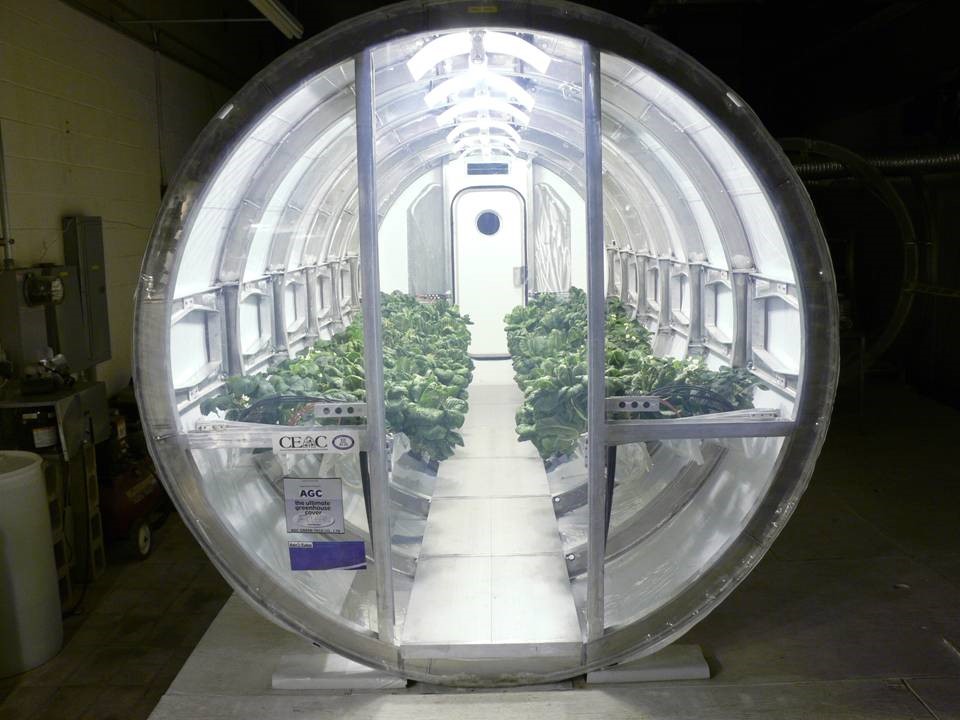6.7 Bioregenerative Life Support for Space Habitats and Earth Applications of Controlled Environment Agriculture
By Gene Giacomelli, Professor & Extension Specialist, Department of Biosystems Engineering, University of Arizona
Murat Kacira, Director, Controlled Environment Agriculture Center, Professor, Department of Biosystems Engineering, University of Arizona
Increasing the capability and robustness of water and atmospheric revitalization within a closed system by food plant production practices.
Bioregenerative Life Support Systems (BLSS) can be achieved with food production procedures within enclosed environmentally controlled confines which recycle 100% of irrigation water and plant nutrients, while collecting inedible biomass for recycling. In the process CO2 is transformed into plant biomass for human food while oxygen is created by photosynthesis.
BLSS represents an important solution to the problem of sustaining long-term human presence in space and on other planets. A BLSS employs plants and crop production to provide air revitalization, water recycling, waste recycling, and food production. BLSS developments have been sponsored by many space agencies around the world including NASA, ESA , China and JAXA (e.g. MELISSA program for ESA1 and CELSS for NASA2.
The University of Arizona team of engineers, scientists, and industry partners has been actively proposing novel design and implementation of BLSS for future habitat and science outposts. The conceptual lunar habitat is equipped with a BLSS within a lunar greenhouse prototype (LGH), and would be covered with regolith (Figure 1). The project involves the design, construction, and operation of an innovative 5.5 m long by 1.8 m diameter membrane-covered LGH with a hydroponic crop production system in a controlled environment that exhibits a high degree of future lunar mission fidelity. The demonstration LGH module operates and is monitored with a Cable Culture hydroponic crop system producing some of the NASA candidate crops. The research supported by the NASA Steckler Space Grant Phase I (January 2010 – June 2011), II (July 2011 – June 2013), and III (2014 – 2017) focused on continuing the operation of the UArizona-BLSS LGH.
Figure 1. Prototype BLSS Lunar Greenhouse (LGH) with Cable Culture currently in operation at UA-CEAC

The overall objective of this project was to establish the technical merit and feasibility of a high-fidelity membrane structure (i.e. the existing prototype Lunar Greenhouse (LGH)), and its food production system (Cable Culture) by demonstrating and evaluating its performance. NASA targeted crops have been grown, in combination, to maturity, including lettuce, tomato, sweet potato, and strawberry or cowpea, to maximize both the volume space utilization of the LGH and the radiation intercepted for plant growth, and to determine the biomass production per area (or volume) per unit time and to quantify water recycling, air revitalization, food production, energy usage and labor demand per unit of production.
The production outputs and resource inputs of the LGH system were determined in Phase I as the average daily increase of plant biomass (0.06 ± 0.01 kg m-2 day-1 wet weight basis (ww), and average water condensate production (21.4 ± 1.9 L day-1) while consuming an average of 25.7 L day-1 of water and 0.22 kg day-1 of CO2 with an average electrical power consumption of 100.3 kWh day-1 (361.1 MJ day-1). Thus, the LGH system produced about 24 ± 4 g biomass (ww) per kWh (83 g biomass (ww) per MJ) of electrical energy with a labor demand of an average of 35.9 min day-1 for operations.
Terrestrial agricultural applications for BLSS
Crop production in controlled environment agriculture (CEA) greenhouses can provide year-round production of food crops in many Arizona locations. For instance, CEA production of leafy greens can use 90% less water per unit produced and tomato production can use 15-20% less water per unit produced compared to seasonal open field agriculture, with consistent yields and assured quality. BLSS concepts that reduce inputs of energy, water, fertilizers, labor, and disposable wastes required for space agriculture can be similarly applied for Earth-based agriculture. Water delivery, plant water use and water disposed are optimized for the most efficient production, while crops ‘pack out’ at nearly 100% with little losses during production. There now exists the equivalent of thousands of acres of food production throughout the US in economically viable greenhouse businesses, yet they produce as little as 10% of the yearly national demand for vegetables such as lettuce, leafy greens, and tomatoes. Enhancing CEA in Arizona and other semi-arid regions, especially with limited natural water supplies, will be a timely alternative for food production agriculture.
BLSS for Circularity
Producing food crops within local greenhouse systems leads to recycling irrigation and nutrient water, eliminating environmental impact of water and soil contamination with fertilizer salts, and maximizing fresh quality vegetables to markets with minimized loss to shrinkage in the markets. Inedible biomass is concentrated within the greenhouse allowing for ease of collection and organized for composting providing organic matter for soil amendments, or processing to extract nutrients for future crops. Unused nutrient water can be applied to traditional outdoor crops. Solar energy availability for production of electrical power can become the source of input energy to the CEA food production system.
For more information:
- Controlled Environment Agriculture Center, University of Arizona
- Ohio Controlled Environment Agriculture Center













